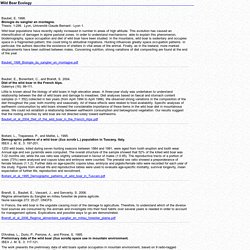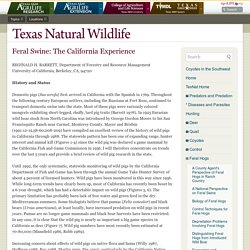

MALME: Wild Boar Ecology. From data obtained by radio-tracking in different study areas, daily spatial behaviour of wild boar has been analysed, with the purpose of assessing the role of this behaviour in the spatial organisation of the populations.

Analysis addressed differences between sex-age categories, and life-time changes, for two parameters of the daily activity (distance between successive resting places; greatest distance to the starting point) and daily patterns derived from them. Despite important differences in forest cover between study areas, this factor seems almost ineffective. Influence of the period is significant only in females with dependent young, and subadult males; it is marked by longer distances between resting places during the September-March period.
During this period, differences between sexes are increased in adults. Baubet_et_al_2004_Diet_of_the_wild_boar_in_the_French_Alps.pdf. Boitani_et_al_1995_Demographic_patterns_of_wild_boar_in_Tuscani.pdf. Estimating wild boar (Sus scrofa) abundance and density using capture–resights in Canton of Geneva, Switzerland. We estimated wild boar abundance and density using capture–resight methods in the western part of the Canton of Geneva (Switzerland) in the early summer from 2004 to 2006.

Ear-tag numbers and transmitter frequencies enabled us to identify individuals during each of the counting sessions. We used resights generated by self-triggered camera traps as recaptures. Program Noremark provided Minta–Mangel and Bowden’s estimators to assess the size of the marked population. The minimum numbers of wild boars belonging to the unmarked population (juveniles and/or piglets) were added to the respective estimates to assess total population size. Over the 3 years, both estimators showed a stable population with a slight diminishing tendency. Diet and habitat use of wild boar (Sus scrofa) in SW-Germany. Titre du document / Document title Auteur(s) / Author(s) Affiliation(s) du ou des auteurs / Author(s) Affiliation(s) (1) Arbeitsbereich Wildökologie und Jagdwirtschaft, Forstzoologisches Institut, Universität Freiburg, Fohrenbühl 27, 79252 Stegen-Wittental, ALLEMAGNE Résumé / Abstract Les tableaux de chasse indiquent qu'en Allemagne et, en particulier, dans le land de Bade-Wurtemberg, les populations de sangliers, Sus scrofa, ont commencé à s'accroître de façon dramatique dans les années 1980.

Revue / Journal Title Source / Source. Keuling_Diss_V2.pdf. Escape movements of family groups of wild boar Sus scrofa influenced by drive hunts in Lower Saxony, Germany - ScienceBase-Catalog. 10.2461-wbp.2007.3. Feral Swine: The California Experience « Texas Natural Wildlife. REGINALD H.

BARRETT, Department of Forestry and Resource Management University of California, Berkeley, CA, 94720 History and Status Domestic pigs (Sus scrofa) first arrived in California with the Spanish in 1769. Throughout the following century European settlers, including the Russians at Fort Ross, continued to transport domestic swine into the state. Most of these pigs were variously colored mongrels exhibiting short-legged, chuffy, lard pig traits (Barrett 1978).
Until 1992, the only systematic, statewide monitoring of wild pigs by the California Department of Fish and Game has been through the annual Game Take Hunter Survey of about 4 percent of licensed hunters. Increasing concern about effects of wild pigs on native flora and fauna (Willy 1987, Hoffman 1988, Ray 1988, Martin 1990, Nie 1992), particularly by the California Native Plant Society, lead to passage of legislation (Senate Bill 819) in 1991 modifying the Fish and Game’s management program for wild pigs. Research. Feral%20Pig%20Eradication.pdf. Biology of Feral Hogs « Texas Natural Wildlife. ERIC C.

HELLGREN, Caesar Kleberg Wildlife Research Institute, Campus Box 218, Texas A&I University, Kingsville, TX 78363 Abstract: Feral hog (Sus scrofa) abundance and distribution have been increasing in Texas in recent years, yet information on hog biology and population dynamics has not kept pace. I review preliminary research on hogs conducted in post oak savannah, gulf coastal prairie, and south Texas plains ecoregions. Range and habitat use, food habits, nutrition, and disease status of feral swine in Texas appear to follow patterns observed elsewhere in North America. Reproductive and demographic data are urgently needed to understand growth rates and to properly manage hog populations in the state.
Keuling_Diss_V2.pdf.